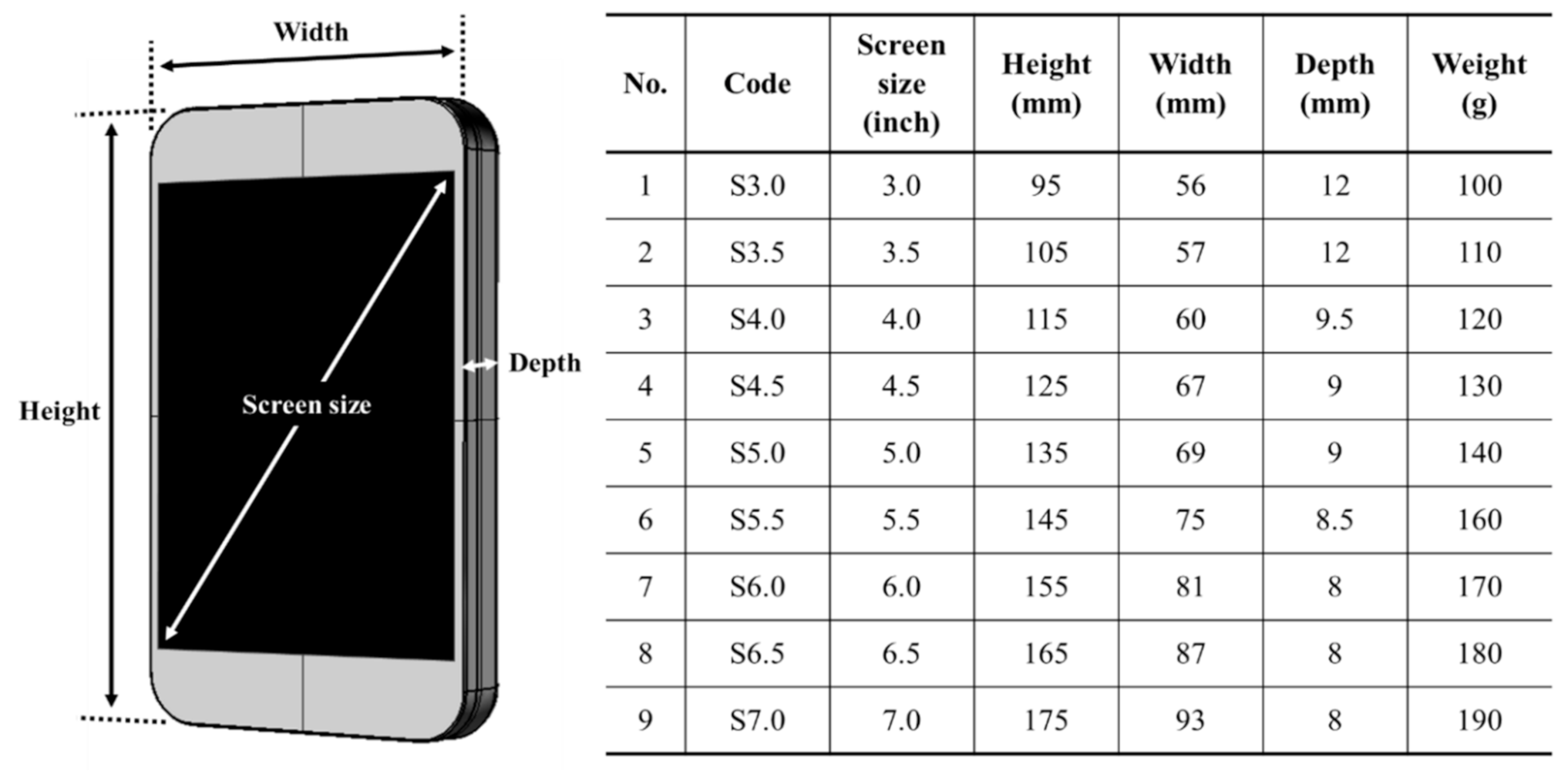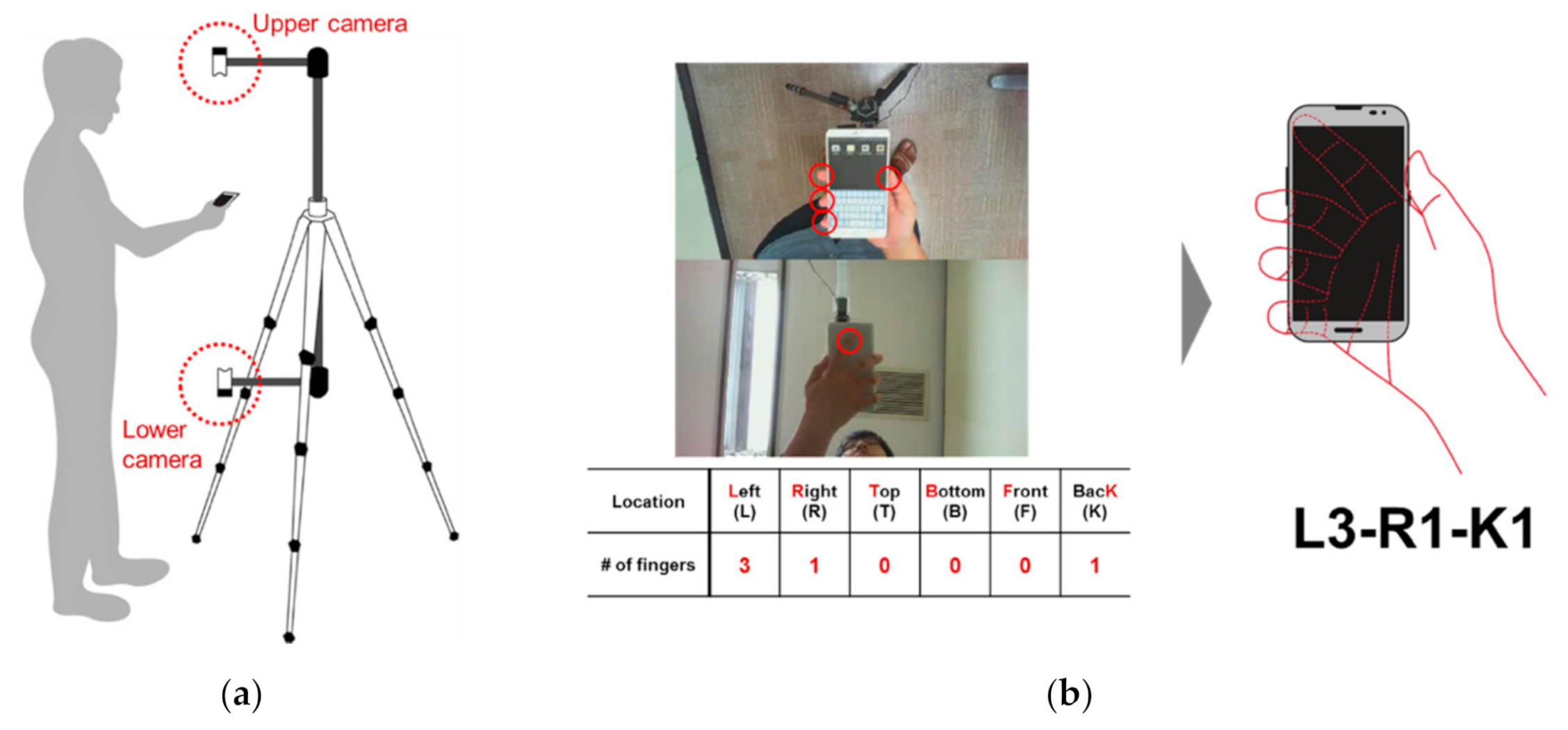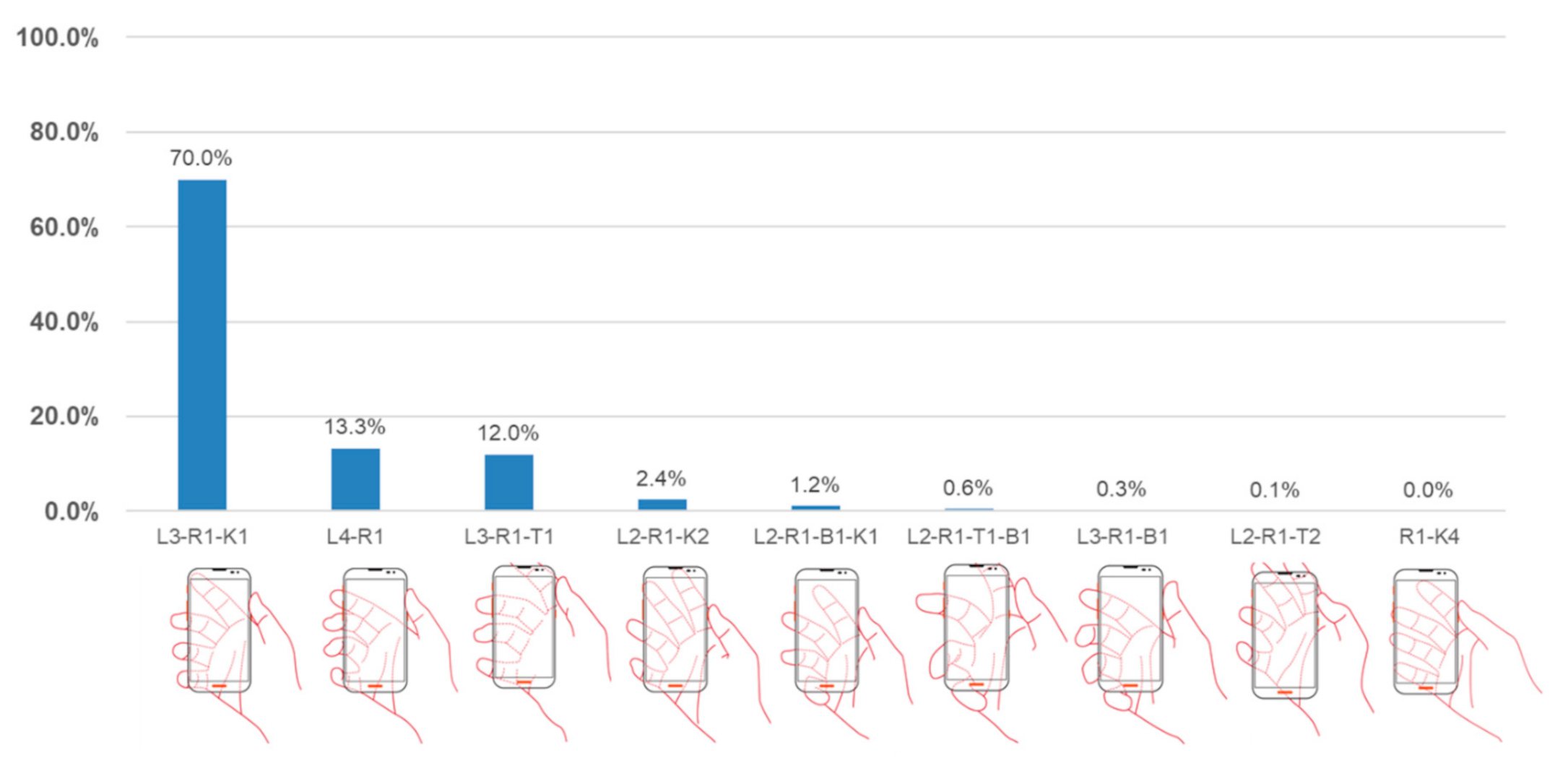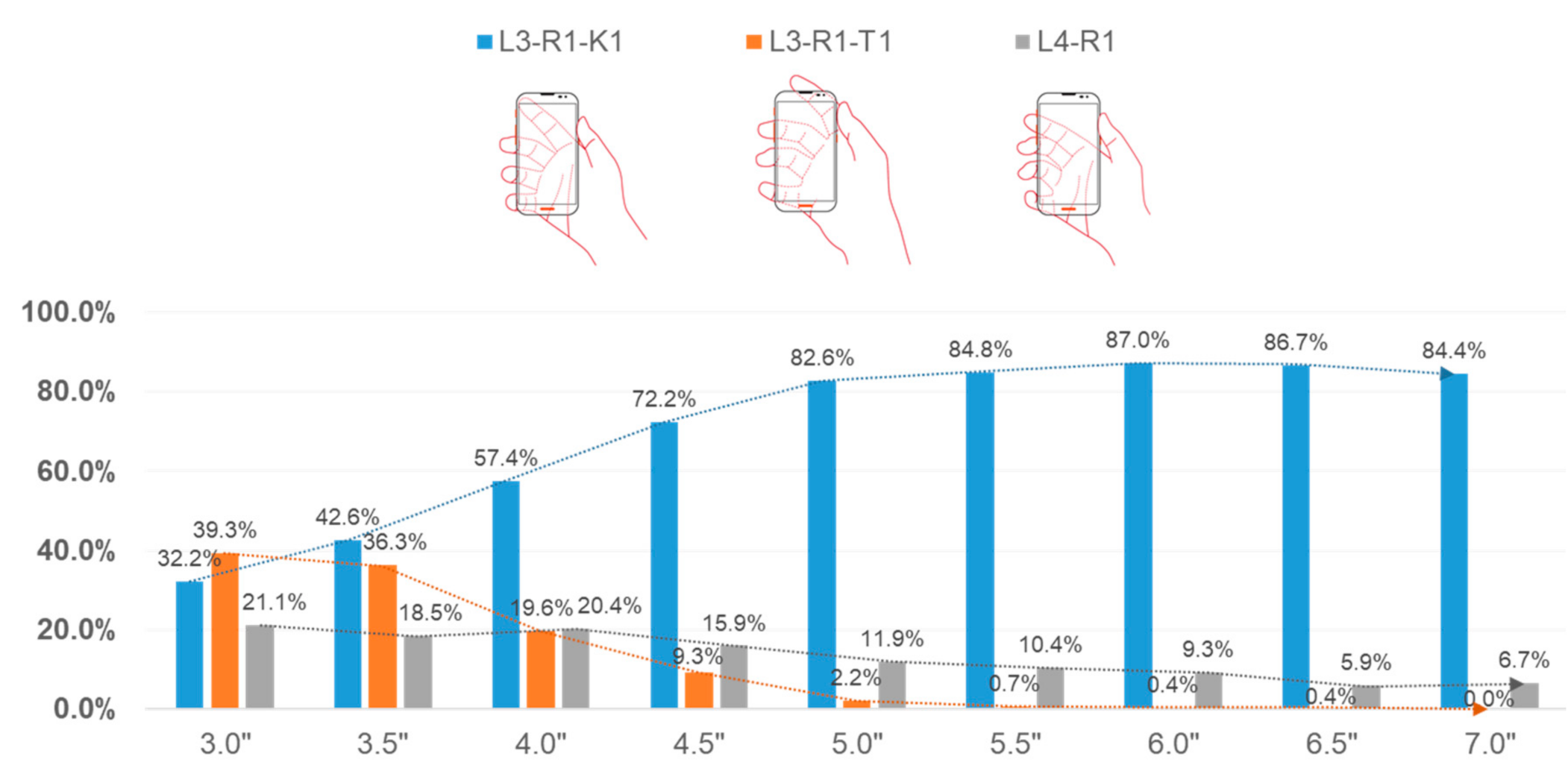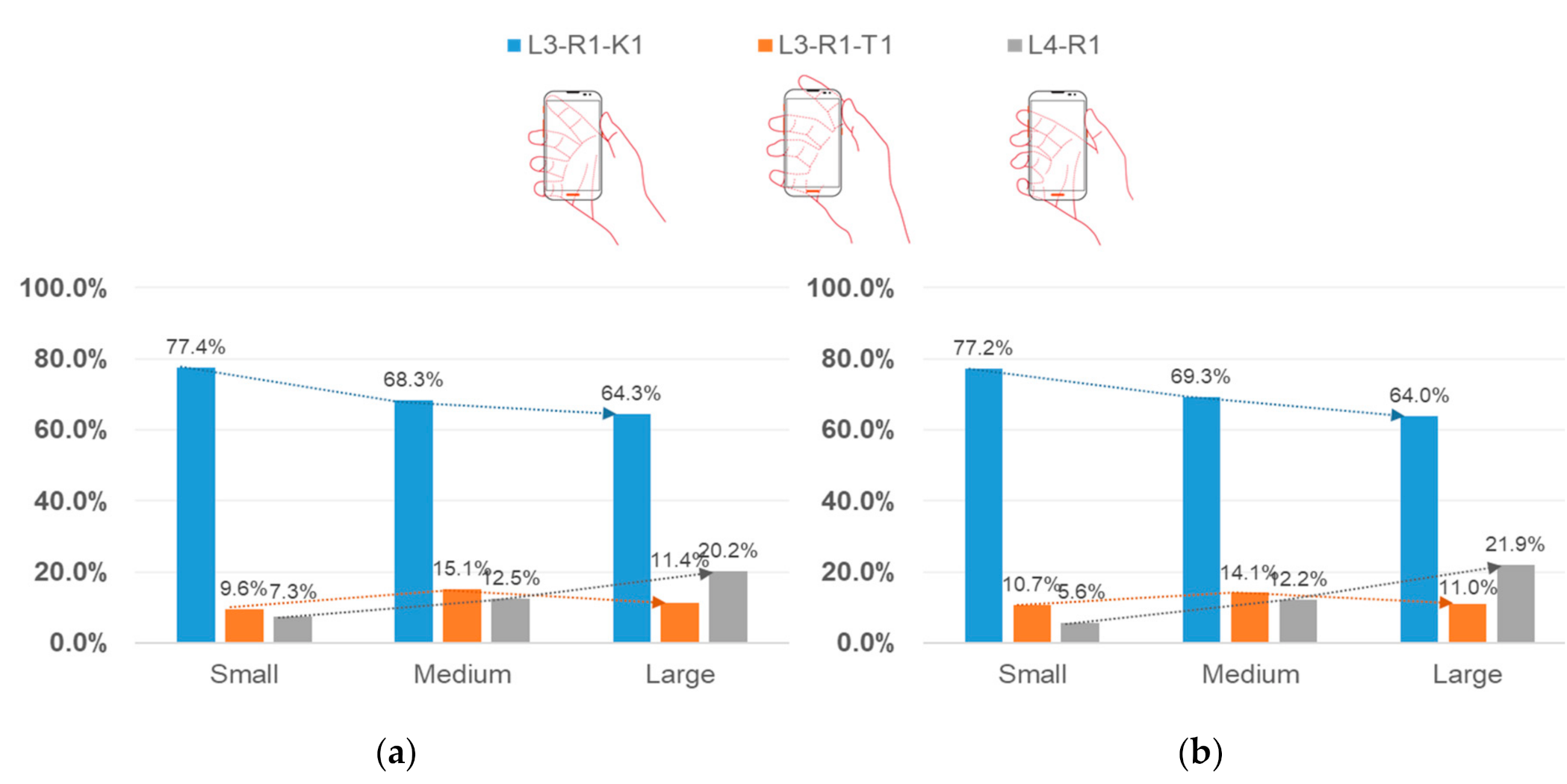1. Introduction
Greater understanding user-preferred grip postures in one-handed operation of hard keys on a smartphone is needed to determine their optimal locations for better operational efficiency and comfort. Hard keys are used on a smartphone for volume adjustment, power on/off, and screen on/off. The operational efficiency of the hard keys can be improved if they are properly located based on the information of user-preferred grip postures. Improperly designed locations of the hard keys may lead to discomfort and inefficiency in finger motions due to awkward hand posture [
1,
2]. Since one-handed (single hand) hard key operations have more usability problems than two-handed (both hands) hard key operations in terms of mobility of the fingers, comfort, efficiency of key operation, and stability of grip [
3,
4,
5], the locations of the hard keys need to be determined by considering user-preferred grip postures in a one-handed hard key operation.
No research has been conducted to examine the effects of task type, device size, and hand size on user-preferred grip posture to determine the proper locations of hard keys on a hand-held mobile device. Various tasks such as checking an email, searching on the internet, taking a photo, sending a text message, making a call, and answering a call require different grip postures with different frequencies [
6]. For example, in a one-handed operation, a light grip is used for searching on the internet by moving the thumb on the touch screen while supporting the back of the smartphone with the four fingers, while a firm grip is used for locking/unlocking the phone by grasping the sides of the phone firmly to apply a significant force to the power key. Next, Pelosi et al. analyzed the effects of finger location on antenna performance parameters in various grip postures for talk and data modes in mobile phones: soft grip (the sides of a phone are held by the distal phalanges) and firm grip (the sides of a phone are held by the intermediate phalanges) in one-handed operations [
7]. Myllymaki et al. investigated various arrangements of capacitive proximity sensors on a mobile phone for recognition of grip position [
8]. Wobbrock et al. compared four one-handed grip postures (thumb-on-front, thumb-on-back, index-on-front, and index-on-back) in terms of task completion time and selection error rate in a target area selection task on the touch screen of a personal digital assistant (PDA) [
2]. Lastly, Tu et al. investigated user-defined gestures on a tablet PC depending on three holding postures [
9,
10]. However, the existing studies do not examine user-preferred grip postures for smartphone hard key operation tasks, which are important to determine the proper locations of hard keys on a smartphone for operation efficiency and comfort.
The present study was intended to identify grip postures preferred by users with various hand sizes in one-handed hard key operations for major smartphone tasks with smartphones of various screen sizes. Grip postures captured by web cameras were encoded by the locations of a smartphone and the number of fingers at each contact location and the frequencies of grip postures were analyzed. Lastly, the effects of smartphone size and hand size on user-preferred grip posture were analyzed.
3. Results
A total of nine grip postures were identified from the experiment for power and volume key operations on the mockups, and of them, three grip postures (L3-R1-K1, L4-R1, and L3-R1-T1) were found to be dominant, having a total of 95% of use frequency, as shown in
Figure 4. The grip posture L3-R1-K1 (holding the left side of a smartphone with three fingers, the right side with the thumb, and the back with the index finger) was most dominant with a frequency of 70.0% over 2430 (= 45 participants × 9 device sizes × 2 hard keys × 3 repetitions) grip posture measurements. Lastly, L4-R1 (holding the left side with the four fingers and the right side with the thumb) and L3-R1-T1 (holding the left side with three fingers, the right side with the thumb, and the top with the index finger) were the second and third most dominant grip postures with 13.3% and 12.0% of frequency for hard key operations, respectively.
The frequency distribution of grip posture varied significantly by smartphone size, as shown in
Figure 5 (
χ2(12) = 674.8,
p < 0.001). The frequency of L3-R1-K1 linearly increased from 32.2% to 82.6% over the smartphone size range of 3.0 to 5.0 inches and then levelled off in the smartphone size range of 5.0 to 7.0 inches, while that of L4-R1 gradually decreased from 21.1% to 6.7% over the smartphone size range of 3.0 to 7.0 inches and that of L3-R1-T1 linearly decreased from 39.3% to 2.2% over the smartphone size range of 3.0 to 5.0 inches and became negligible (<1%) in the smartphone size range of 5.5 to 7.0 inches. Lastly, the skewness of a frequency distribution of the three dominant grip postures increased toward L3-R1-K1 as smartphone size increased: a slightly skewed frequency distribution (32.2% for L3-R1-K1, 39.3% for L3-R1-T1, and 21.1% for L4-R1) for the 3.0-inch smartphone to a highly skewed frequency distribution (84.4% for L3-R1-K1, <0.1% for L3-R1-T1, and 6.7% for L4-R1) for the 7.0-inch smartphone.
Lastly, the frequency distribution of grip posture varied significantly by hand width and hand length with a similar pattern as shown in
Figure 6 (
χ2(4) = 75.3,
p < 0.001 for hand width and
χ2(4) = 103.4,
p < 0.001 for hand length). As hand width and hand length increased from small to large, the frequency of L3-R1-K1 decreased from 77.4% to 64.3% and from 77.2% to 64.0%, respectively. On the other hand, as hand width and hand length increased from small to large, the frequency of L4-R1 increased from 7.3% to 20.2% and from 5.6% to 21.9%, respectively. Lastly, as hand width increased from small to large, the frequency of L3-R1-T1 increased from 9.6% to 15.1% and then decreased to 11.4%; likewise, as hand length increased from small to large, the frequency of L3-R1-T1 increased from 10.7% to 14.1% and then decreased to 11.0%.
4. Discussion
The present study analyzed preferred grip postures by users with different hand sizes and their frequencies in one-handed operations of the smartphone hard keys (power and volume keys), which are needed to determine optimal locations of hard keys on a smartphone for efficiency and comfort. Properly designed hard key locations based on an analysis of user-preferred grip postures can enhance grip stability and reduce discomfort in the use of a smartphone [
1,
2]. Although one-handed smartphone operations cause more discomfort and usability problems than two-handed smartphone operations, users often prefer one-handed operations for efficiency and convenience reasons [
17]. However, systematic studies on one-handed smartphone grip postures in hard key operations considering smartphone size and hand size have not been conducted. In the present study, one-handed smartphone grip postures were captured by camera and encoded by the number of fingers at each side of a smartphone. Dominant grip postures in hard key operations on smartphones were identified by analyzing the frequency distribution of grip posture, which can be used to determine the proper hard key locations of a smartphone with a particular size.
The smartphone grip posture analysis method employed in the present study based on the number of fingers at each side of a smartphone was found to be effective in describing various smartphone grip postures and identifying dominant grip postures in terms of frequency. Two web cameras vertically positioned apart enabled the hand in grip position on a smartphone to be efficiently captured. Ref. [
7] classified smartphone grip postures into soft and firm grips by visual inspection, while the present study quantitatively classified grip postures by the number of fingers at each side of the phone. The proposed method can be applied to measurement and analysis of grip postures for operations of not only hard keys but also graphical user interfaces (GUI) on a touch screen and other smartphone physical user interfaces such as a fingerprint sensor.
The present study identified that nine grip postures are used for hard key operations, and out of those nine, three postures are dominant with a total frequency of 95.3% for smartphones of 3.0 to 7.0-inch screen size. The dominant grip postures include L3-R1-K1 (last three fingers at the left side, thumb at the right side, and index finger at the back of smartphone), L4-R1 (four fingers at the left side and thumb at the right side of smartphone), and L3-R1-T1 (last three fingers at the left side, thumb at the right side, and index finger at the top of smartphone). The dominant grip postures are similar in the aspect that the middle, ring, and little fingers are located at the left side and thumb at the right side of a smartphone, but are different in the aspect that the index finger is located at the back of a smartphone for L3-R1-K1, the left side for L4-R1, and the top for L3-R1-T1. The dominant grip postures enable the right hard keys to be easily operated by the thumb and the left hard keys by the index or middle finger while the device is being firmly held. In particular, L3-R1-K1 was found to be most dominant with a frequency of 70.0% because it enables users to switch fast between L4-R1 and L3-R1-T1 by moving the index finger to the left side and the top of a smartphone. Note that the subsequent three dominant grip postures, L2-R1-K1-B1, L3-R1-B1, and L2-R1-T1-B1 (total of frequencies = 4.7%), slightly differ from the three dominant postures in that the little finger is positioned to the bottom of a smartphone, instead of the left side, to support the base of the device more firmly.
The frequency distribution of grip posture by smartphone size identified that dominant grip postures with > 10% of frequency change by smartphone size: L3-R1-K1, L4-R1, and L3-R1-T1 for 3.0 to 4.0 inches of screen size, L3-R1-K1 and L4-R1 for 4.5 to 5.5 inches, and only L3-R1-K1 for 6.0 to 7.0 inches. The change in grip posture frequency distribution by smartphone size can be explained by the transition from holding small smartphones with a low height (e.g., 95 mm) by L3-R1-T1 or ones with a narrow width (e.g., 56 mm) by L4-R1 to holding large smartphones with a high height (e.g., 175 mm) or ones with a wide width (e.g., 93 mm) by L3-R1-K1, because users tend to move their index finger on the top or left-side for small smartphones and to the back for large smartphones for secure grip and support.
Next, the frequency distribution of grip posture by hand size identified an increase in L4-R1 by 12.9% and 16.3% and a decrease in L3-R1-K1 by 13.1% and 13.2% as hand width and hand length increased from small to large, respectively. The change in grip posture frequency distribution by hand size can be explained by the observation that the index finger can be located more naturally at the left side of a smartphone as hand size increases because users with a large hand usually grasp a smartphone along a diagonal direction of their hand with a straight wrist posture while keeping the smartphone display vertical.
The findings of the present study need to be verified by users of a wider range of ages and having hand sizes beyond the hand size range of the present study and in use contexts other than standing. Users younger or older than their 20s and having smaller or larger hands than the hand size range of the participants in the present study need to be included to generalize the grip posture analysis results of the present study to the global user population because possible effects of age and hand size on grip posture beyond the ranges of age and hand size not explored in the present study. Next, the present study measured comfortable grip postures while users simulated smartphone tasks while standing in a laboratory environment; thus, grip postures of a smartphone in other use contexts such as sitting, lying, and walking need to be examined. Although the standing use context was selected in the present study for ease and efficiency in grip posture measurement, other use contexts need to be considered to examine if the distribution of grip posture changes depending on use context. For example, the grip posture of L3-R1-K1 preferred in the standing use context can be changed to L4-R1 in the walking use context to grasp a smartphone more firmly due to an increased likelihood of a drop and therefore damage to the device. Novel methods of grip posture measurement in natural and dynamic use contexts need to be developed to investigate user-preferred grip postures in various use contexts. Moreover, grip postures with real smartphones need to be investigated since mockups were used in the present study. Users can use different grip postures when holding the mockups made of white Acrylonitrile Butadiene Styrene (ABS) by 3D printer compared to holding real smartphones manufactured by molding and coated by various finishes of high quality. In addition, users can grasp in a safer way when using real smartphones to prevent dropping and damage.
Lastly, research on the determination of optimal locations of hard keys on a smartphone using the identified dominant grip postures is needed. The proper locations of hard keys can be determined by identifying preferred areas for hard key operations with users with different hand sizes while the identified dominant grip postures are used. For example, the preferred area of the left hard key for L4-R1 would vary by hand size and be located higher than that for L3-R1-K1. Thus, the optimal locations of hard keys on a smartphone of a particular size can be determined by considering hard key locations preferred by the user population with various hand sizes while the smartphone is held by the identified dominant grip postures. For example, the locations for hard keys can be determined by finding the comfortably reachable locations in the grip postures of L3-R1-K1, L4-R1, and L3-R1-T1 for users with various hand sizes. The ergonomically determined hard key locations can be evaluated in terms of time efficiency, accuracy, and comfort for validation [
2].

